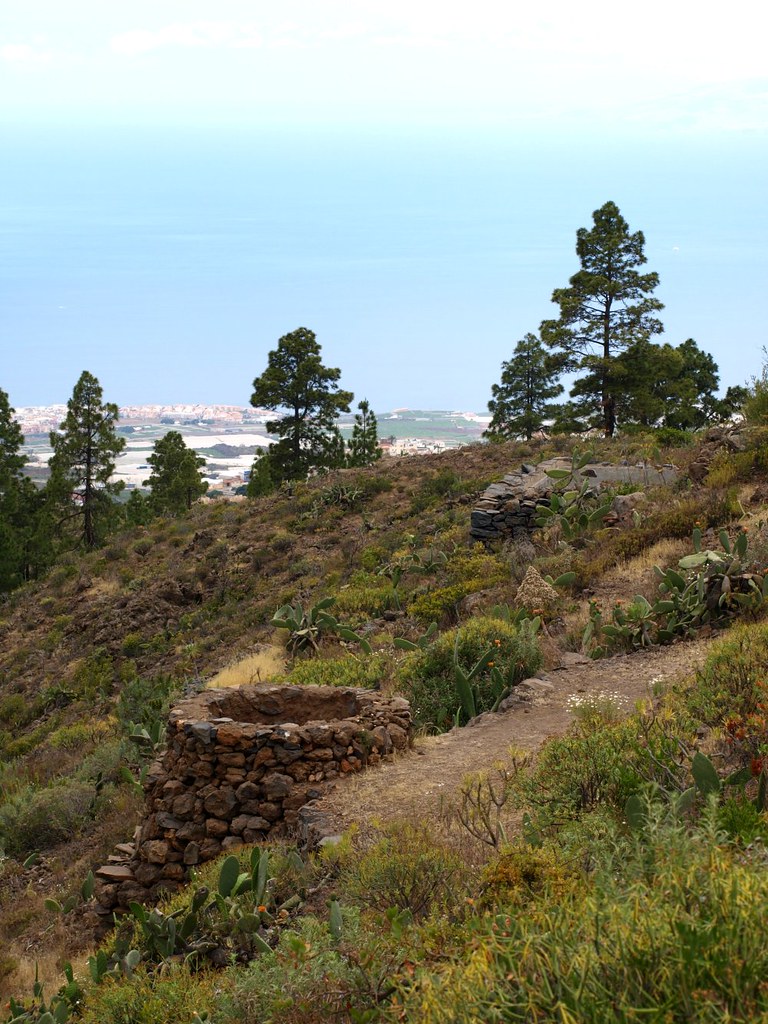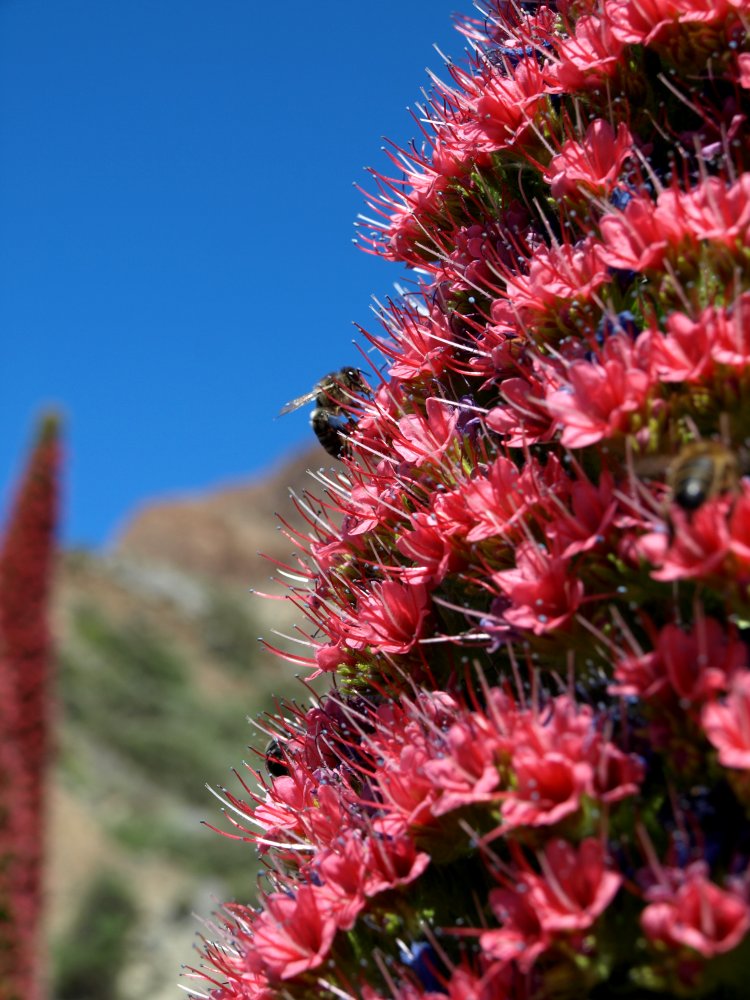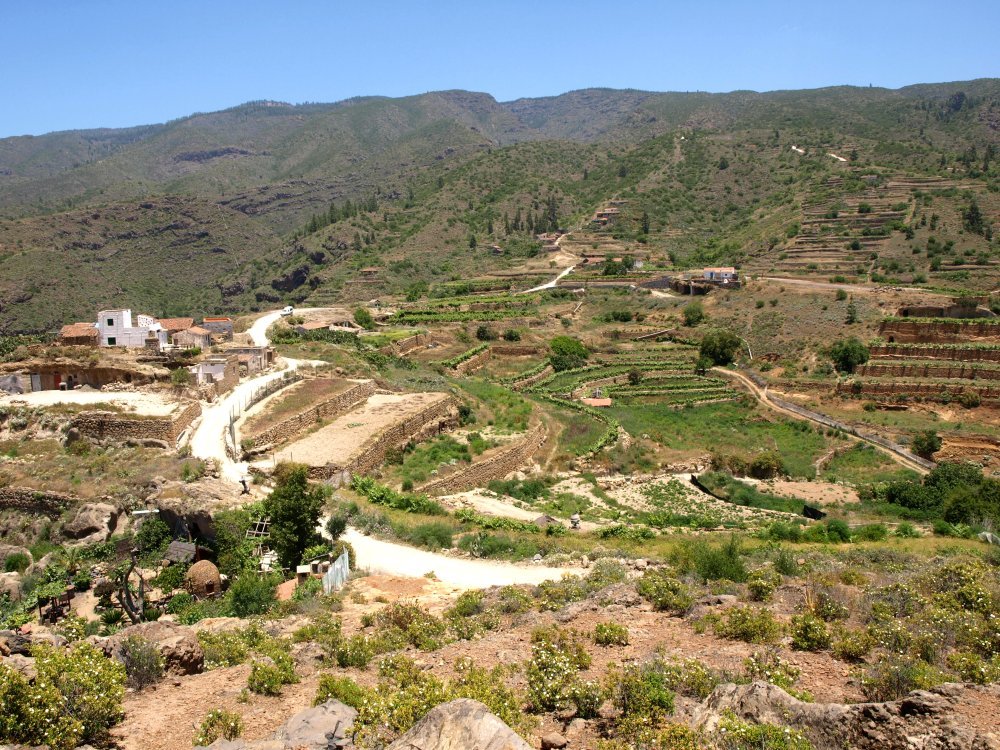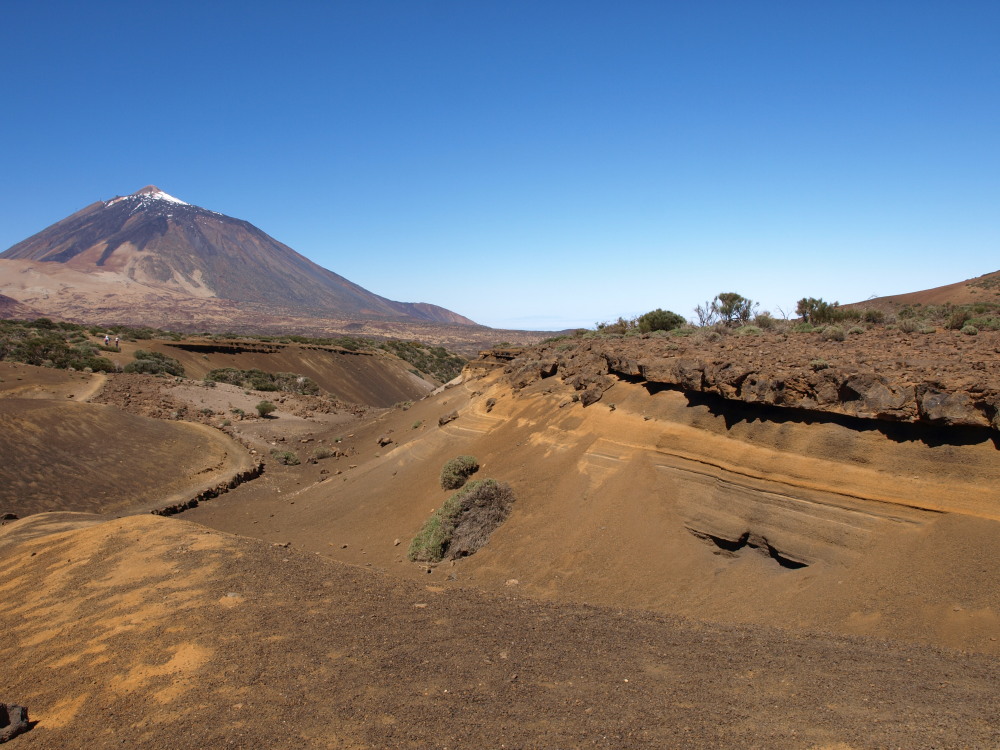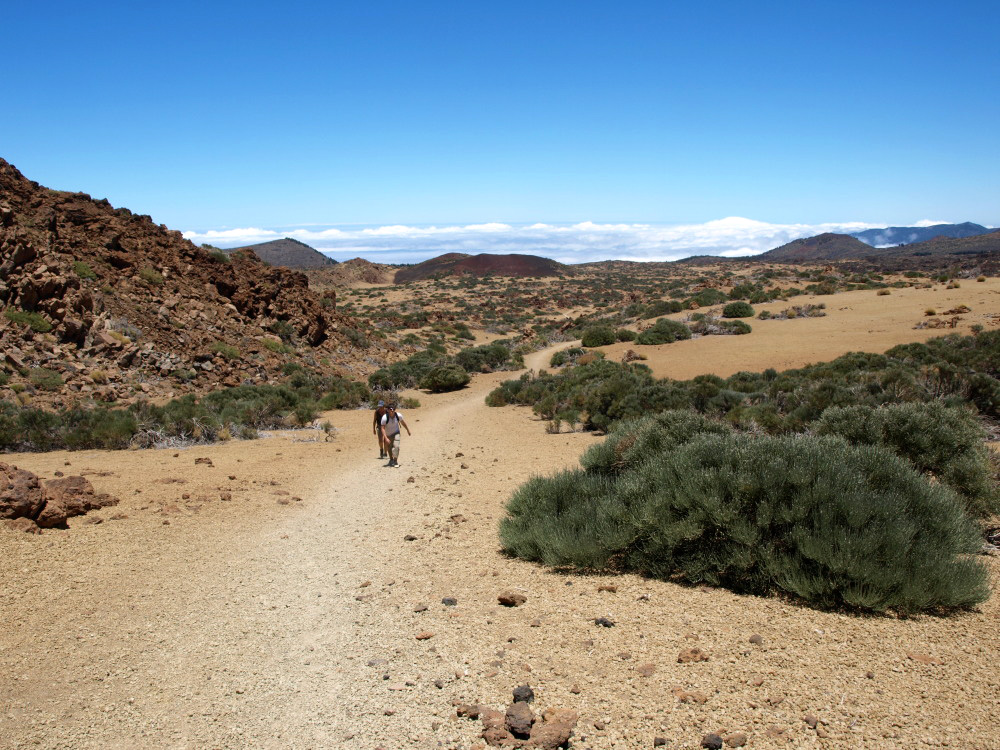We often get asked about walking routes in the west by people who are planning to holiday in and around Los Gigantes. So over the past couple of weeks we’ve been concentrating on that area and trying out some walks.
We knew that there was an old trading path running from somewhere around Guía de Isora up into the hills so last week we set off to find it. We were working off information supplied by the Ayuntamiento (Town Hall) which, as usual, was reprinted on a regular basis without anyone checking if it was still current.
Consequently, the start of the route had long since disappeared, replaced by new roads and walls.
After a precipitous false start and some hesitant exploration, we finally found the route and once we were on our way, were pleasantly surprised to find that it was in fact well signed and easy to navigate. At multiple path junctions, signposts gave good directions and distances, routes were way-marked with painted stripes and there were even information boards at various points, showcasing other routes.
Having enjoyed and chronicled a lovely, rural, circular route we emerged back into Guía alongside someone’s house, at the bottom of a dead end, accessed via a series of climbs, twists and turns through housing estates, with not a single signpost to mark it. Had we been looking to start the walk from that side, we would probably still be wandering around Guía now.
That same afternoon we drove further up into the hills to do a short(ish) route at the start of which a brand new, fancy sign had been erected by the Cabildo (Island Government).
Within metres of setting off from the sign, we were unsure of which way to go, our indecision hampered by two small dogs growling and snapping at our heels. Once we’d found an overgrown semblance of a path, it split off in different directions constantly with no marker signs for guidance. Although we were alongside a steep barranco (ravine) and so our direction was pretty obvious, finding the way through was proving to be impossible.
After aborted attempts to drop down dodgy trails on the side of the barranco, we finally found our path completely blocked by two parked vans alongside a house. Re-tracing steps; trying different trails and even asking a couple of locals all amounted to nothing. We finally gave up, tired and frustrated with feet embedded with sharp seed heads from wading through the tangled mass of undergrowth.
The Medio Ambiente (Environmental Department) had clearly decided to re-open the path and had begun by putting up the fancy sign. When, or if, they’ll get round to re-claiming the path from man and nature and giving it clear markings is anybody’s guess.
The moral of this tale is that, on Tenerife, you can’t tell a walk from its signpost.
Walking routes for the south west coming soon…
Monday, 31 May 2010
Friday, 28 May 2010
Walking in the Teide Crater – It's Tajinaste Time
They don't seem as though they belong. In an other-worldly setting they look like visitors from another planet themselves; their tall proud spikes standing out against the ruddy tones of the volcanic landscape like splashes of blood on a canvas.
It's easy to believe that they are extra-terrestrial visitors enjoying their annual couple of weeks in Tenerife's sunshine before heading back to who knows where.
If anyone hasn't seen them up close and personal then, at some point before mid June, it's worth making the trip up to Las Cañadas del Teide see the brief but spectacular blooming of the tajinaste plant.
Yesterday we traveled back from the south of Tenerife to Puerto de la Cruz via the crater, hoping that our timing was right and the fields of this unusual plant would be there to welcome us – we weren't disappointed.
As you drive along the roads from the southern entrances toward Mount Teide, the tajinaste aren't always easy to spot; they can behave like shy creatures, keeping just out of sight below ridges beside the road. But once you know where they are it's impossible to miss them and conveniently they come back to the same spots year after year. They also congregate around the cable car like the human visitors to Tenerife and by the time you're on the road north, they've lost their shyness and huddle around miradors (viewing areas) and stand at the side of the road like flamboyant hitch-hikers.
But it's essential to get in amongst them by foot to really appreciate their uniqueness. We must have timed it perfectly this year as the island's bees were enjoying their annual shopping trip to the tajinaste – the black spots in the picture aren't dust on the camera lens – and the air was alive with excited buzzing as I leaned in close to try to get some intimate shots of the bees on the flowers. I wasn't particularly concerned that bees were buzzing around my head; there was only one thing on their little insect radar and it wasn't me. I was able to take photo after photo without fear of getting zapped by a bee.
Visiting the tajinaste in bloom is one of those unique little experiences that makes walking on Tenerife ultra special and witnessing these amazing plants bloom in such spectacular style in such a dry, violent landscape makes the soul soar. I can't recommend it enough.
It's easy to believe that they are extra-terrestrial visitors enjoying their annual couple of weeks in Tenerife's sunshine before heading back to who knows where.
If anyone hasn't seen them up close and personal then, at some point before mid June, it's worth making the trip up to Las Cañadas del Teide see the brief but spectacular blooming of the tajinaste plant.
Yesterday we traveled back from the south of Tenerife to Puerto de la Cruz via the crater, hoping that our timing was right and the fields of this unusual plant would be there to welcome us – we weren't disappointed.
As you drive along the roads from the southern entrances toward Mount Teide, the tajinaste aren't always easy to spot; they can behave like shy creatures, keeping just out of sight below ridges beside the road. But once you know where they are it's impossible to miss them and conveniently they come back to the same spots year after year. They also congregate around the cable car like the human visitors to Tenerife and by the time you're on the road north, they've lost their shyness and huddle around miradors (viewing areas) and stand at the side of the road like flamboyant hitch-hikers.
But it's essential to get in amongst them by foot to really appreciate their uniqueness. We must have timed it perfectly this year as the island's bees were enjoying their annual shopping trip to the tajinaste – the black spots in the picture aren't dust on the camera lens – and the air was alive with excited buzzing as I leaned in close to try to get some intimate shots of the bees on the flowers. I wasn't particularly concerned that bees were buzzing around my head; there was only one thing on their little insect radar and it wasn't me. I was able to take photo after photo without fear of getting zapped by a bee.
Visiting the tajinaste in bloom is one of those unique little experiences that makes walking on Tenerife ultra special and witnessing these amazing plants bloom in such spectacular style in such a dry, violent landscape makes the soul soar. I can't recommend it enough.
Wednesday, 26 May 2010
Walking on Tenerife – Those Boots Were Made For Walking
My favourite boots are a pair of old Camel boots that I've probably worn about twenty times. I was completely seduced by an advert in a travel magazine which basically showed a foot resting on a log in a clearing in the jungle. On the foot was a gleaming Camel boot which looked about as at home in that exotic setting as a piece of leather, not actually on an animal, could be. I couldn't resist them.
Their first outing was to Kenya where they seemed just the ticket for exploring Tsavo East on foot. The reality though was that, as walking boots go, they turned out to be a complete bust. They might have looked the part, but just walking from the safari lodge bar to a table overlooking a watering hole with a G&T (don't actually drink the stuff, but it did seem appropriate) to enjoy sunset was enough to bring up a blister. In the end I carried them around Kenya instead of them carrying me.
Since then I've learned to choose my footwear carefully when it comes to buying shoes for practical reasons; something that when you're tackling Tenerife's diverse range of landscapes is a far more sensible approach.
Footwear for Walking on Tenerife
My number one walking boots for donkey's years have been a trusty pair of brasher's, similar to their current Hillmaster boot. I brought them from Britain with me and they've proved equal to the task of tackling all of Tenerife's terrains from the sliding volcanic scree on the way to the summit of Mount Teide to pine covered forest floors in the forests of the Orotava Valley and icy slopes in Las Cañadas del Teide.
These sort of sturdy boots are good all rounders for exploring the island on foot. But mine can feel quite heavy in the summer months when the temperature rises off the scale and boots like the brasher can make my feet feel as though they're a wee bit overdressed.
So when the temperatures rise, and the terrain permits, I tend to switch to a walking sandal. For a long time I wore a pair of Merrells when walking in summer months (between May and the end October) in areas where the ascents weren't too steep or slippery (good for coastal walks). They struggled a bit with some of the terrain, especially in the upper La Orotava Valley where a bit of dry floor ski-ing can add some excitement to trails when the forest floor is thick with pine needles. It was on one such walk that one of them fell apart mid-walk (to be fair I'd had them for a few years and they'd seen some action).
I couldn't find a suitable replacement until I spotted what looked like an almost identical pair of sandals in my local supermarket at a fraction of the price. To be honest I didn't expect much of them and tried them out on a short coastal walk around Las Ramblas in Los Realejos to see how they'd hold up. It turned out they felt no different from my old Merrells and two years later they're still going strong. They were an incredible bargain considering they cost me €2.99.
Recently I added another addition to my walking footwear stable, a pair of Quechua lightweight walking shoes. I could feel my feet sigh with joy as I tried them out for the first time on a trek last week. The temperature was hovering around 30 degrees and the terrain was more uneven than I'd expected with a couple of steep ascent/descents but the shoes stuck to the path as though they had solvent on them. After 15 kilometres my feet and the shoes were still best of mates.
The only downside was that they were so comfortable that at the end of the walk I was denied that delicious pleasure of peeling off my boots and walking socks and slipping them into an airy pair of sandals to let them breathe a sigh of relief.
It was only their first outing, they'll get the second tomorrow, so it'll be interesting to see how they hold up over the long term.
They won't be sturdy enough for the most serious walks like climbing Teide, or even the muddy Anaga paths after the winter rains, but it looks as though the brashers are going to get a well earned rest over the summer.
Their first outing was to Kenya where they seemed just the ticket for exploring Tsavo East on foot. The reality though was that, as walking boots go, they turned out to be a complete bust. They might have looked the part, but just walking from the safari lodge bar to a table overlooking a watering hole with a G&T (don't actually drink the stuff, but it did seem appropriate) to enjoy sunset was enough to bring up a blister. In the end I carried them around Kenya instead of them carrying me.
Since then I've learned to choose my footwear carefully when it comes to buying shoes for practical reasons; something that when you're tackling Tenerife's diverse range of landscapes is a far more sensible approach.
Footwear for Walking on Tenerife
My number one walking boots for donkey's years have been a trusty pair of brasher's, similar to their current Hillmaster boot. I brought them from Britain with me and they've proved equal to the task of tackling all of Tenerife's terrains from the sliding volcanic scree on the way to the summit of Mount Teide to pine covered forest floors in the forests of the Orotava Valley and icy slopes in Las Cañadas del Teide.
These sort of sturdy boots are good all rounders for exploring the island on foot. But mine can feel quite heavy in the summer months when the temperature rises off the scale and boots like the brasher can make my feet feel as though they're a wee bit overdressed.
So when the temperatures rise, and the terrain permits, I tend to switch to a walking sandal. For a long time I wore a pair of Merrells when walking in summer months (between May and the end October) in areas where the ascents weren't too steep or slippery (good for coastal walks). They struggled a bit with some of the terrain, especially in the upper La Orotava Valley where a bit of dry floor ski-ing can add some excitement to trails when the forest floor is thick with pine needles. It was on one such walk that one of them fell apart mid-walk (to be fair I'd had them for a few years and they'd seen some action).
I couldn't find a suitable replacement until I spotted what looked like an almost identical pair of sandals in my local supermarket at a fraction of the price. To be honest I didn't expect much of them and tried them out on a short coastal walk around Las Ramblas in Los Realejos to see how they'd hold up. It turned out they felt no different from my old Merrells and two years later they're still going strong. They were an incredible bargain considering they cost me €2.99.
Recently I added another addition to my walking footwear stable, a pair of Quechua lightweight walking shoes. I could feel my feet sigh with joy as I tried them out for the first time on a trek last week. The temperature was hovering around 30 degrees and the terrain was more uneven than I'd expected with a couple of steep ascent/descents but the shoes stuck to the path as though they had solvent on them. After 15 kilometres my feet and the shoes were still best of mates.
The only downside was that they were so comfortable that at the end of the walk I was denied that delicious pleasure of peeling off my boots and walking socks and slipping them into an airy pair of sandals to let them breathe a sigh of relief.
It was only their first outing, they'll get the second tomorrow, so it'll be interesting to see how they hold up over the long term.
They won't be sturdy enough for the most serious walks like climbing Teide, or even the muddy Anaga paths after the winter rains, but it looks as though the brashers are going to get a well earned rest over the summer.
Monday, 24 May 2010
Organised Walks – A Bee's View of Mount Teide
Here's an interesting little guided walking route – El Teide A Vista De Abeja. It's based around an area which is a magnet to bees-the Fasnia Volcano, and is as much about the flora, bees and honey as it is about enjoying the stunning scenery.
There are limited places available and a €15 fee includes transport from La Laguna. The 7 km walk takes place on Saturday 29th May; the perfect time for a walk in the crater as the tajinaste should be in full bloom.
For more information call the Tenerife Rural office on 922 531 013
There are limited places available and a €15 fee includes transport from La Laguna. The 7 km walk takes place on Saturday 29th May; the perfect time for a walk in the crater as the tajinaste should be in full bloom.
For more information call the Tenerife Rural office on 922 531 013
Creating A Barrier Free Paradise – Tenerife's First Wheelchair Friendly Path
Last week the first wheelchair friendly forest path was opened by Tenerife president, Ricardo Melchior in Tacoronte's highlands.
The specially developed path is in Agua García, next to the Barranco de Toledo, and covers a distance of 860 metres (both ways) through the forest.
It might only be a small concession to opening up Tenerife's countryside to people who may not otherwise be able to enjoy it, but it is a commendable one.
The specially developed path is in Agua García, next to the Barranco de Toledo, and covers a distance of 860 metres (both ways) through the forest.
It might only be a small concession to opening up Tenerife's countryside to people who may not otherwise be able to enjoy it, but it is a commendable one.
Friday, 21 May 2010
Walking on Tenerife – Into the Unkown; South West Tenerife
I get excited by the thought of walking in areas that you rarely hear mentioned, so when we parked the car in a hamlet above Tenerife's south west and headed to what we had worked out would be the start of the new walking route we were researching, I had mixed emotions when we were faced with a shiny new board with information about the route.
I say mixed emotions because on the one hand I wanted to feel we were exploring territory which is generally ignored even by the island's most enthusiastic walkers. On the other it was good to see that the local council were recognising that walking on Tenerife has enormous potential and providing signs to help walkers find their way around this wonderfully diverse island is a step in the right direction.
Within a hundred yards we realised that whilst the board was a step, it was a baby-sized one. Ahead of us were three paths; none signposted. It turned out that the signpost at the start of the route was the one and only signpost along an old merchants' trail which skirted abandoned houses and terraces, with potential paths leading off in various directions along the way.
Six years ago, when we first started exploring Tenerife on foot, I'd have been flummoxed by the lack of clarity regarding the way ahead. But experience since then of not relying on signs, trusting our instincts, and learning to spot the merest hint of a path hidden by the overgrown undergrowth has made us a bit wiser. I say a bit - there are still times when Tenerife's maze of trails confound, that's when the old compass comes in handy.
As it happened we successfully found our way to our objective, a partly abandoned valley hidden in the folds of the hills without use of the compass. And to be truthful, the lack of sign posts and directions on many Tenerife walking routes adds a buzz to finding our way to places which are way, way off the beaten track.
However, visitors to Tenerife who fancy exploring its rural delights and head off along a signposted trail to find themselves faced with tracks heading in all directions and no more signposts to show the way, may not agree that 'buzz' is an accurate description of the emotion they feel at that point.
Thursday, 20 May 2010
Walking on Tenerife: The Abandoned Village of Las Fuentes
For me the best walks on Tenerife, or anywhere, involve routes which offer lots of interesting curios, OMG scenery moments and also have something that little bit different which sets them apart form other walks.
The route we followed yesterday fitted this criteria perfectly. As we navigated our way along a partially overgrown merchants' trail, we detoured to an old tile oven and a communal water tank which in the past was used to refresh the animals and clean the clothes – imagine cleaning your laundry next to a slavering great beast of burden.
The path also skirted the occasional abandoned house, one of which occupied an enviable spot with vistas from Alcalá all the way to the edge of Costa Adeje. We spent a few minutes exploring and imagining how wonderful it would look when fully renovated. Oddly enough the place was littered with the soles of old shoes making us wonder if a zapatero (shoemaker) had lived here.
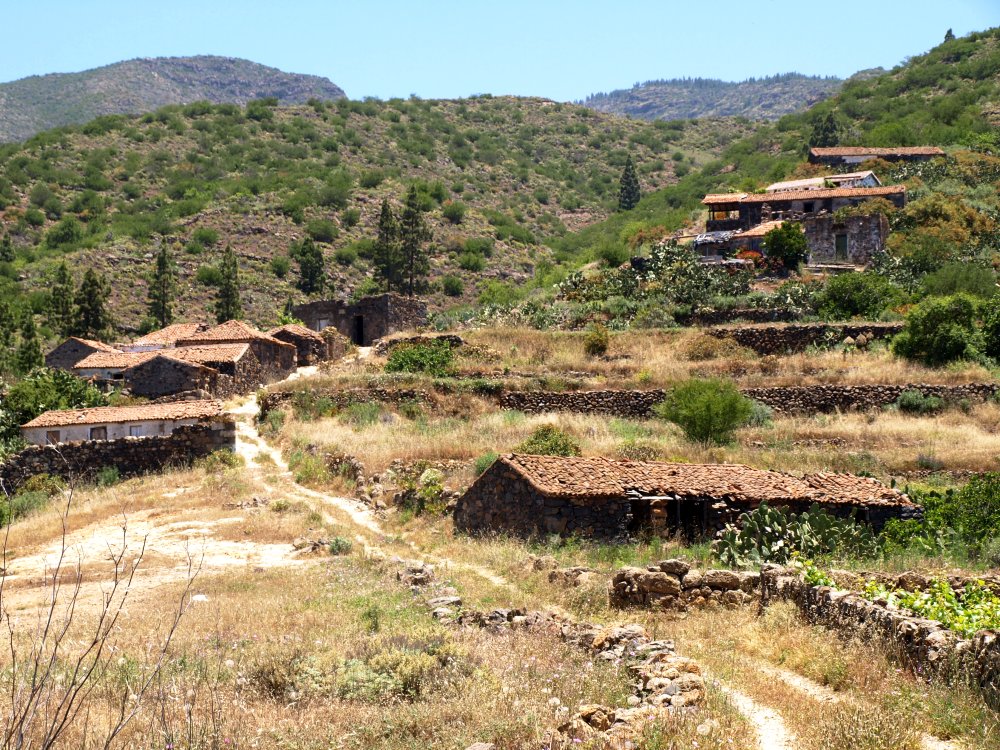 All around was evidence of a thriving agricultural past that had been long since abandoned, possibly because of the lure of a far more lucrative income offered by the pleasure palaces on the coast below. There were rows of neat empty terraces, more eras (threshing circles) than I've ever seen in one area and old disused fountains where the green slimy puddles showed that the water of life still trickled.
All around was evidence of a thriving agricultural past that had been long since abandoned, possibly because of the lure of a far more lucrative income offered by the pleasure palaces on the coast below. There were rows of neat empty terraces, more eras (threshing circles) than I've ever seen in one area and old disused fountains where the green slimy puddles showed that the water of life still trickled.
We followed a cobbled trail lined by tabaiba, cactus groves and wild lavender, stopping where paths merged to make educated guesses (hopefully) at the right direction. The path undulated along gentle ravines before a completely hidden path ascended steeply to a ridge, then descended to the base of an oasis of a ravine where it disappeared into wild vines and long whispering grass.
Tracing the faintest outline we pushed the foliage apart and made or way up through a narrow ravine until we reached a point in the path where a pumice dry-stone wall bordered one side and an agricultural enclosure the other. The contents of the enclosure were covered so I couldn't see what was being grown, but it was clear that it had been tended recently; up ahead the faint sound of human voices broke the silence.
I've got to admit to my imagination running away a wee bit here and suddenly visions of Leo DiCaprio in The Beach entered my head. This was supposed to be an abandoned valley, yet it clearly wasn't. Suppose it was now a marijuana factory or something?
However rationality knocked these fanciful thoughts from my head. I've never walked anywhere that feels safer than Tenerife; the chances of being machine-gunned were remote to say the least.
We carried on toward the voices and pushed a curtain of grass aside...and there it was; Las Fuentes, an immaculate little agricultural valley hidden away in the hills.
I love those moments when you reach the highlight of a walk when suddenly one step opens up a whole new world. The Montaña Guajara walk is a bit like that. But this was a place I'd never even seen a photograph of, so it felt extra special.
A couple of old guys tending a row of vines were the only signs of life in the place. They told us that they sold their wine in Guia further down the hill and pointed out where the path continued. We spent some time exploring the hamlet before scrabbling up to an ermita high above the village where we ate lunch, drank spring water from a fountain in the village and generally just enjoyed the hot sunshine atop what must be the best viewpoint along the south west coast.
This sort of experience is what walking on Tenerife is all about.
A detailed guide of the route will be added to Tenerife Island Walks soon, that's a definite.
The route we followed yesterday fitted this criteria perfectly. As we navigated our way along a partially overgrown merchants' trail, we detoured to an old tile oven and a communal water tank which in the past was used to refresh the animals and clean the clothes – imagine cleaning your laundry next to a slavering great beast of burden.
The path also skirted the occasional abandoned house, one of which occupied an enviable spot with vistas from Alcalá all the way to the edge of Costa Adeje. We spent a few minutes exploring and imagining how wonderful it would look when fully renovated. Oddly enough the place was littered with the soles of old shoes making us wonder if a zapatero (shoemaker) had lived here.
 All around was evidence of a thriving agricultural past that had been long since abandoned, possibly because of the lure of a far more lucrative income offered by the pleasure palaces on the coast below. There were rows of neat empty terraces, more eras (threshing circles) than I've ever seen in one area and old disused fountains where the green slimy puddles showed that the water of life still trickled.
All around was evidence of a thriving agricultural past that had been long since abandoned, possibly because of the lure of a far more lucrative income offered by the pleasure palaces on the coast below. There were rows of neat empty terraces, more eras (threshing circles) than I've ever seen in one area and old disused fountains where the green slimy puddles showed that the water of life still trickled. We followed a cobbled trail lined by tabaiba, cactus groves and wild lavender, stopping where paths merged to make educated guesses (hopefully) at the right direction. The path undulated along gentle ravines before a completely hidden path ascended steeply to a ridge, then descended to the base of an oasis of a ravine where it disappeared into wild vines and long whispering grass.
Tracing the faintest outline we pushed the foliage apart and made or way up through a narrow ravine until we reached a point in the path where a pumice dry-stone wall bordered one side and an agricultural enclosure the other. The contents of the enclosure were covered so I couldn't see what was being grown, but it was clear that it had been tended recently; up ahead the faint sound of human voices broke the silence.
I've got to admit to my imagination running away a wee bit here and suddenly visions of Leo DiCaprio in The Beach entered my head. This was supposed to be an abandoned valley, yet it clearly wasn't. Suppose it was now a marijuana factory or something?
However rationality knocked these fanciful thoughts from my head. I've never walked anywhere that feels safer than Tenerife; the chances of being machine-gunned were remote to say the least.
We carried on toward the voices and pushed a curtain of grass aside...and there it was; Las Fuentes, an immaculate little agricultural valley hidden away in the hills.
I love those moments when you reach the highlight of a walk when suddenly one step opens up a whole new world. The Montaña Guajara walk is a bit like that. But this was a place I'd never even seen a photograph of, so it felt extra special.
A couple of old guys tending a row of vines were the only signs of life in the place. They told us that they sold their wine in Guia further down the hill and pointed out where the path continued. We spent some time exploring the hamlet before scrabbling up to an ermita high above the village where we ate lunch, drank spring water from a fountain in the village and generally just enjoyed the hot sunshine atop what must be the best viewpoint along the south west coast.
This sort of experience is what walking on Tenerife is all about.
A detailed guide of the route will be added to Tenerife Island Walks soon, that's a definite.
Monday, 10 May 2010
Walking Above the Clouds on Tenerife
One of our computers has been in hospital for the last three weeks where it was being lovingly brought back to life by the guys at SITEL in Puerto de la Cruz (if you need work on your computer, these are the guys to go to).
The reason I mention this is that when we were putting the finishing touches to our new 'Hiking Highs – Walking Routes in Teide National Park' I realised that I couldn't find the most up to date photos from the last time we walked up to the summit of Montaña Guajara.
Adding the finishing touches to our Island Walks routes really means slotting the photos into place – it's one of those lovely little jobs which basically involves going through my library of photos to see which ones fit best.
One of the ones I wanted to use was a shot of Andy standing above the clouds. Looking down from above the clouds is one of Tenerife's true 'WOW' experiences. If anyone out there hasn't enjoyed the privilege, emerging above a sea of clouds is like being on a plane when it breaks through a thick bank of clouds to emerge in an intense blue, cloudless sky above a cotton wool landscape.
It's one of those moments that remind you that Tenerife is a very special place with a seemingly endless stock of magical experiences that, ironically, the vast majority of its millions of visitors never, ever witness.
Anyway I searched and searched for the image, but couldn't find it. Although I regularly back up my photos, there was one set that I had missed and which I realised lay, possibly gone forever, in the computer that was ill. This situation was a right bugger. There are some shots where it doesn't matter (towns etc), where I can just go out and get them again, but the summit of Guajara isn't one of those places where you can just nip out to to replace lost photos.
However, the computer was returned last week, pulled back from death's door Lazarus-like by the miracle workers at SITEL and lo and behold my Guajara photos were saved.
In the end I used an image from a previous walk, which I probably like better, but this is the one I was going to use.
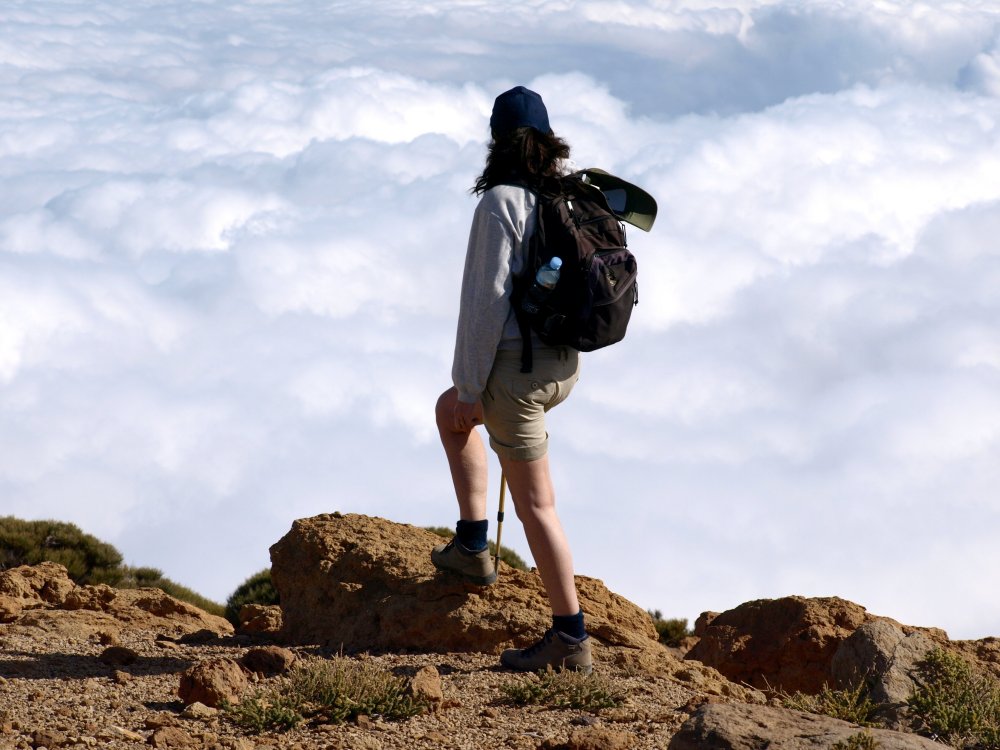
Isn't that an incredible vista?
The reason I mention this is that when we were putting the finishing touches to our new 'Hiking Highs – Walking Routes in Teide National Park' I realised that I couldn't find the most up to date photos from the last time we walked up to the summit of Montaña Guajara.
Adding the finishing touches to our Island Walks routes really means slotting the photos into place – it's one of those lovely little jobs which basically involves going through my library of photos to see which ones fit best.
One of the ones I wanted to use was a shot of Andy standing above the clouds. Looking down from above the clouds is one of Tenerife's true 'WOW' experiences. If anyone out there hasn't enjoyed the privilege, emerging above a sea of clouds is like being on a plane when it breaks through a thick bank of clouds to emerge in an intense blue, cloudless sky above a cotton wool landscape.
It's one of those moments that remind you that Tenerife is a very special place with a seemingly endless stock of magical experiences that, ironically, the vast majority of its millions of visitors never, ever witness.
Anyway I searched and searched for the image, but couldn't find it. Although I regularly back up my photos, there was one set that I had missed and which I realised lay, possibly gone forever, in the computer that was ill. This situation was a right bugger. There are some shots where it doesn't matter (towns etc), where I can just go out and get them again, but the summit of Guajara isn't one of those places where you can just nip out to to replace lost photos.
However, the computer was returned last week, pulled back from death's door Lazarus-like by the miracle workers at SITEL and lo and behold my Guajara photos were saved.
In the end I used an image from a previous walk, which I probably like better, but this is the one I was going to use.

Isn't that an incredible vista?
Monday, 3 May 2010
Walking on Tenerife – Simply Stunning Scenery from Off the Beaten Track #3
For this month's Stunning Scenery shots, we're heading up into Teide National Park for two contrasting landscapes.
The first is taken above Arenas Negras alongside a small ravine where the wind has eroded the rock face, revealing its volcanic layers in shades of coffee and cream. Millions of years of volcanic activity has created layers of different types of rock and volcanic fallout which, when revealed, form beautiful patterns of marbled swirls. The best example of this layering effect is at La Tarte on the amazing route along Tenerife's spine from La Laguna to Teide.
The quick way back to the crater floor from this spot is straight down the face of Arenas Negras itself, scurrying and sliding down the volcanic surface. We call it volcano surfing and it's great family fun, if a little nervy in parts. If you fancy giving a go, follow the Arenas Negras route in Hiking Highs.
The second shot is taken on a path that leads from behind the El Portillo Visitor centre to Montaña Blanca where the serious business of ascending Mount Teide on foot begins.
The landscape here is vast and littered with volcanic debris, cones and craters, all of which just beg to be scaled so you can look inside; a temptation which is only given into once as the altitude and the soft terrain take their toll on thigh muscles.
Teide National park has many different faces and wildly contrasting landscapes depending on which area you choose to explore but the one thing they all have in common is self evident in both these shots; leave the beaten track with its coachloads of visitors and you'll soon find yourself alone with the lizards in this unearthly wonderland.
The first is taken above Arenas Negras alongside a small ravine where the wind has eroded the rock face, revealing its volcanic layers in shades of coffee and cream. Millions of years of volcanic activity has created layers of different types of rock and volcanic fallout which, when revealed, form beautiful patterns of marbled swirls. The best example of this layering effect is at La Tarte on the amazing route along Tenerife's spine from La Laguna to Teide.
The quick way back to the crater floor from this spot is straight down the face of Arenas Negras itself, scurrying and sliding down the volcanic surface. We call it volcano surfing and it's great family fun, if a little nervy in parts. If you fancy giving a go, follow the Arenas Negras route in Hiking Highs.
The second shot is taken on a path that leads from behind the El Portillo Visitor centre to Montaña Blanca where the serious business of ascending Mount Teide on foot begins.
The landscape here is vast and littered with volcanic debris, cones and craters, all of which just beg to be scaled so you can look inside; a temptation which is only given into once as the altitude and the soft terrain take their toll on thigh muscles.
Teide National park has many different faces and wildly contrasting landscapes depending on which area you choose to explore but the one thing they all have in common is self evident in both these shots; leave the beaten track with its coachloads of visitors and you'll soon find yourself alone with the lizards in this unearthly wonderland.
Subscribe to:
Comments (Atom)
